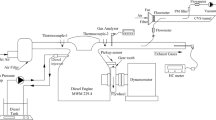Abstract
The Brazilian legislation does not establish limits or methodology for the measurement of aldehydes in the exhaust of heavy diesel engines. No conclusive studies on aldehyde emissions by such engines have been found in the literature available. This work measured the aldehyde emissions from a P7 diesel cycle engine (EURO V), which was tested on an engine test bench according to ETC (European Transient Cycle) and ESC (European Stationary Cycle) cycles using fuels with 5, 7 and 20% v/v of biodiesel and 10 and 500 ppm of sulphur. The results showed that biodiesel participation in the mixture did not significantly affect the aldehyde emissions of the tested engine and that the emission level generated in the ETC cycle is higher than that obtained with the ESC cycle. The diesel content in the blend was weakly and negatively correlated with the pollutant emissions, and the inverse pattern was observed for biodiesel. This finding indicates that an increase in biodiesel content causes a slight increase in pollutant emissions. Regarding the sulphur content, positive correlations between the sulphur content and particulate matter, NOx, CO and total hydrocarbon emissions were observed. When comparing the test cycles, the results were significantly different, with higher values for the ETC cycle.












Similar content being viewed by others
References
ABNT NBR 12026 (2009) Light road vehicles—determination of aldehydes and ketones in exhaust gas by liquid chromatography—DNPH method
Abrantes R, Assunção JV, Hirai EY (2005) Emissions of aldehydes from light duty vehicles. Rev Saúde Pública 39(3):479–485
Anderson LG (2012) Effects of biodiesel fuels use on vehicle emissions. J Sustain Energy Environ 3:35–47
André M, Rapone M (2009) Analysis and modelling of the pollutant emissions from European cars regarding the driving characteristics and test cycles. Atmos Environ 43:986–995
Caplain I, Cazier F, Nouali H, Mercier A, Déchaux J, Nollet V, Joumard R, André J, Vidon R (2006) Emissions of unregulated pollutants from European gasoline and diesel passenger cars. Atmos Environ 40:5954–5966
Chin J, Batterman S, Northrop W, Bohac S, Assanis D (2012) Gaseous and particulate emissions from diesel engines at idle and under load: comparison of biodiesel blend and ultralow sulfur diesel fuels. Energy Fuel 26:6737–6748
CONAMA. Resolution No. 403/2008—about the obligation of the new phase of control program of air pollution by automobiles—PROCONVE for new heavy vehicles (Phase P-7)”. Publication DOU no. 220, de 12/11/2008, pp. 92–93
Daemme LC, Penteado RA, Pereira F, Ferreira RS (2011) Criteria and non-criteria emissions generated by a light diesel vehicle. XXVI International Symposia of Automobile Engineering (SIMEA), São Paulo
Daemme LC, Penteado RA, Silva KC, Errera MR, Zotin F (2014) Regulated and non-regulated emissions from a light-duty diesel car fueled with different diesel sulfur content. SAE International. 2014-36-0110
Durbin TD, Pisano JT, Younglove T, Sauer CG, Rhee SH, Huai T, Miller JW, Mackay GI, Hochhauser AM, Ingham MC, Gorse RA, Beard LK, Dicicco D, Thompson N, Stradling RJ, Rutherford JA, Uihlein JP (2004) The effect of fuel sulfur on NH3 and other emissions from 2000–2001 model year vehicles. Atmos Environ 38:2699–2708
EC, Directive 1999/96/EC of the European Parliament and of the Council of 13 December 1999. Available in <https://eur-lex.europa.eu/LexUriServ/LexUriServ.do?uri=OJ:L:2000:044:0001:0155:EN:PDF>. Accessed 15 June 2019
Guarieiro L, De Souza A, Torres E, De Andrade J (2009) Emission profile of 18 carbonyl compounds, CO, CO2, and NOx emitted by a diesel engine fuelled with diesel and ternary blends containing diesel, ethanol and biodiesel or vegetable oils. Elsevier, Atmos Environ 43:2754–2761
Hoekman SK, Robbins C (2012) Review of the effects of biodiesel on NOx emissions. Fuel Process Technol 96:237–249
Huai T, Durbin TD, Miller JW, Norbeck JM (2004) Estimates of the emission rates of nitrous oxide from light-duty vehicles using different chassis dynamometer test cycles. Atmos Environ 38:6621–6629
Karavalakis G, Bakeas E, Stournas S (2010) Influence of oxidized biodiesel blends on regulated and unregulated emissions from a diesel passenger car. Environ Sci Technol 44:5306–5312
Kursa MB, Rudnicki WR (2010) Feature selection with the Boruta package. J Stat Softw 36:1–13
Lance DL, Goodfellow CL, Willians J, Burting W, Sakata I, Yoshida K, Taniguchi S, Kitano K (2009) The impact of diesel and biodiesel fuel composition on a Euro V HSDI engine with advanced DPNR emissions control. SAE International, 2009-01-1903
Maricq MM (2007) Chemical characterization of particulate emissions from diesel engines. A review. J Aerosol Sci 38:1079–1118
Mccormick R, Alleman TL (2006) Efeito do Biodiesel Sobre a Emissão de Poluentes de Motores Diesel In: Knothe G, Gerpen JV, Krahl J Biodiesel Manual. São Paulo: Edgard Blücher
Melo TC, Penteado Neto RA, Rocha JRS, Ferreira RS (2013) How different biodiesel contents in diesel can affect aldehyde emissions in motor vehicles. XXVIII International Symposia of Automobile Engineering (SIMEA), São Paulo, São Paulo
Nelson PF, Tibbett AR, Day SJ (2008) Effects of vehicle type and fuel quality on real world toxic emissions from diesel vehicles. Atmos Environ 42:5291–5303
R Core Team (2016) R: a language and environment for statistical computing. R Foundation for Statistical Computing, Vienna, Austria. Available in <https://www.R-project.org/>
Rickert G (2015) Overview of emissions on world-harmonised and non-road cycles. Association for Emissions Control by Catalyst—AECC, Technical Seminar on Heavy-duty Engine Emissions Brussels, 25 October 2007. Available in <http://www.aecc.be/content/HD%20Seminar/11__AECC_Rickert.pdf> Accessed 27 June 2018
Schneider J, Hock J, Weimer S, Borrmann S, Kirchner U, Vogt R, Scheer V (2005) Nucleation particles in diesel exhaust: composition inferred from in situ mass spectrometric analysis. Environ Sci Technol 39:6153–6161
Stanislaus A, Marafi A, Rana MS (2010) Recent advances in the science and technology of ultra low sulfur diesel (ULSD). Catal Today 153:1–68
Tan P, Hu Z, Lou D (2009) Regulated and unregulated emissions from a light-duty diesel engine with different sulfur content fuels. Fuel 88:1086–1091
Tiancun X, Lidun A, Weimin Z, Shishan S, Guoxin X (1992) Mechanism of sulfur poisoning on supported noble metal catalyst—the adsorption and transformation of sulfur on palladium catalysts with different supports. Catal Lett 12:287–296
U.S.EPA (2002) A comprehensive analysis of biodiesel impacts on exhaust emissions. Draft technical report. EPA420-P-02-001-October 2002
Verbeek R, Smokers RTM, Kadijk G, Hensema A, Passier GLM, Rabé ELM, Kampman B, Riemersma IJ (2008) Impact of biofuels on air pollutant emissions from road vehicles. TNO report, MON-RPT-033-DTS-2008–01737
Wang WG, Lyons DW, Clark NN, Gautam M, Norton PM (2000) Emissions from nine heavy trucks fueled by diesel and biodiesel blend without engine modification. Environ Sci Technol 34:933–939
Acknowledgements
The authors acknowledge the Brazilian Ministry of Science and Technology (MCT), the Brazilian National Council for Technological and Scientific Development (CNPq), law 8010, and the staff members of the Lactec Automotive Laboratory (LEME) for providing support for this work.
Author information
Authors and Affiliations
Corresponding author
Additional information
Responsible editor: Philippe Garrigues
Publisher’s note
Springer Nature remains neutral with regard to jurisdictional claims in published maps and institutional affiliations.
Rights and permissions
About this article
Cite this article
Bório, H.F., Penteado, R., Daemme, L.C. et al. Criteria and aldehyde emissions from a diesel Euro V engine using diesel/biodiesel blends in Brazil. Environ Sci Pollut Res 26, 12470–12480 (2019). https://doi.org/10.1007/s11356-019-04345-5
Received:
Accepted:
Published:
Issue Date:
DOI: https://doi.org/10.1007/s11356-019-04345-5




